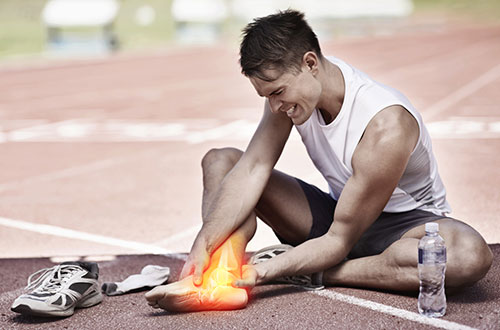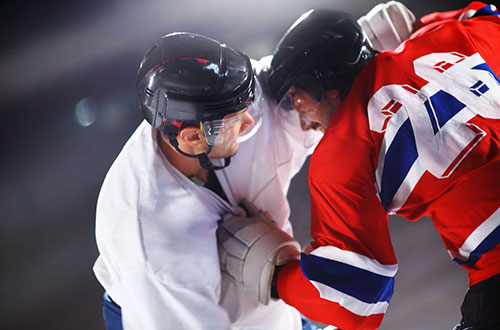
There are a huge swarth of acute and chronic sport injuries that often times go unreported and do not require surgery. These are typically soft tissue injuries of the tendons, ligaments, muscle, nerve, or cartilage and do not include broken bones. Mild injuries which are painful but, do not impede function such as the inability to bear weight or utilize the joint, may likely be treated conservatively at home. Moderate to severe musculoskeletal Injuries which impede the ability to bear weight, perform the sport, or exercise, need evaluation by an expert physician, especially if there is significant pain, swelling, discoloration, bruising, or deformity of the joint or bone(s). In addition to a physical examination by a competent physician, imaging studies like x-ray or MRI, will be needed. Ultrasound, however, is a less invasive and sometimes more accurate way to visualize sports injuries involving soft tissue because, we can pinpoint exactly which and where tendons, ligaments, cartilage, nerve, or muscles, have damage. The RICE protocol (rest, ice, compression, elevation), Tylenol, NSAIDS (ibuprofen or Naproxen), and physical rehabilitation has previously been the gold standards of treatment for sports and exercise related soft tissue injuries. At the BHDRx Sports Medicine, we specialize in cell and ortho-biologic treatments to actually cure, heal, or prevent certain acute or chronic sport injuries without surgery.
Call us for a consultation at to find out if your acute or chronic injury is treatable, employing new and cutting-edge cell and ortho-biologic therapies like PRP, Nanofat, or Exosomes.
10 Most Common Sports Injuries & Preventions
- Knee Injuries: The knee accounts for more than 50% of sports injuries; it is stabilized by tendons, muscle, cartilage, and four ligaments which can be injured commonly playing football, soccer, basketball, etc. Prevention- Normalize to a healthy weight so, ligaments and tendons do not have excessive stress and cartilage does not wear away to beget arthritis. Warm up and stretch before performing your sport so the ligaments and tendons are flexible and can stretch during your activity.
- Ankle Sprain: There are four major ligaments which support the outside and inside of the ankle joint. Accidentally "rolling" the ankle inward commonly leads to a sprain. Prevention-Doing circular and heel-toe pointing range of motion exercises of the foot and ankle, help to increase circulation and stretch the ligaments and Achilles tendon for improved flexibility and injury prevention.
- Tennis or Golfer’s Elbow: Tendonitis of the lateral or medial elbow occur with repetitive or overuse of the elbow, particularly when there is excessive vibration from a racket or club or flexion of the wrist and forearm
- Prevention: Avoid racket vibration, reduce repetitive flexion of wrist and forearm, take frequent breaks, do warm ups, stretches, and strengthen the muscles and tendons of the forearms.
- Hamstring Strain: This happens when the muscles or tendons of the back of the upper leg over stretch. Sometimes the muscle can completely rupture.
- Prevention: Stretch and warm up the thigh muscles in order to loosen any tightness before performing your sport. The hamstring needs to loosen slowly as you increase the intensity of strain you put on it.
- Groin Pull: Adductor muscles are located in the inner thigh and get strained with sudden or excessive stretching of the leg in an outward motion. Prevention- Wear the proper support garment for your sport and do warm up and stretches to prepare for your play. Soccer, for example, needs loose fitting pants to allow unrestricted movement.
- Back Pain: A common problem that occurs with sudden compression of the spine and torso twisting. It can also happen with repetitive and overuse of the back muscles. Prevention-stretching maneuvers to decompress discs, warm ups, and strengthening of the back muscles to promote alignment of the vertebrae will help prevent injury.
- Shin Splints: Shin splints happen with the overloading of the muscles, tendons, and bones of the front of the lower leg. Runners, dancers, and jumpers are often plagued by this. Prevention-Wear comfortable shoes with shock absorption and arch and bony support. Be sure with stretch and warm up prior to performing your sport and gradually increase the intensity.
- Joint islocations: Dislocations occur when there is a sudden and forceful stress placed on a joint which slips out of place.
- Prevention: Avoid joint dislocations by wearing the proper protective gear for your sport and strengthen the muscles surrounding it to maintain anatomic position.
- Bone Fractures: Bone fractures occur when there is too much force or strain placed on a bone which causes it to snap.
- Prevention: Fractures can be prevented with a proper diet including calcium, magnesium, Vitamin D , etc. to grow them strongly plus strengthening the muscles surrounding them. Do wear the protective gear and utilize proper technique for throwing, running, jumping, etc.
- Concussions: Concussions are very common sports injuries which happen when there is a forceful acceleration-deacceleration of the brain within the skull. This can lead to alteration of mental status, loss of consciousness, headache, nausea/vomiting, forgetfulness, etc.
- Prevention: Wearing protective head gear and playing safely are key for prevention. Taking chances is too risky, for a brain is a terrible thing to waste.

